21ea321b0e2275d5e7b33e83ae1db8d6.ppt
- Количество слайдов: 68

Interconnected Systems Framework PA PBS Network Professional Learning Community Webinar #2 February 14, 2017

Agenda § Follow up since 1/27 webinar § Getting Started – District and Community Leadership § Getting Started – Building Level Implementation

Follow Up from Last Time § Questions, feedback, comments § ISF Implementation Inventory § Did not receive any consent to participate

Please Share § One item you took from last webinar back to your site for discussion or follow up § One way you have identified you will use this PLC to advance the goals of your project § One question you would like addressed today

An Interconnected Systems Framework § A Structure and process for education and mental health systems to interact in most effective and efficient way. § guided by key stakeholders in education and mental health/community systems § who have the authority to reallocate resources, change role and function of staff, and change policy.

Core Features Aligned § Effective teams that include community mental health providers, family/youth § Data based decision making § Formal processes for the selection and implementation of evidence based practices (EBP) § Early access through use of comprehensive screening § Rigorous progress-monitoring for both fidelity and effectiveness § Ongoing coaching at both the systems and practices level.

Getting Started - DCLT

Example of Work Flow Checklist 1. 2. 3. 4. 5. 6. 7. Select District and Schools Form or Expand District Team (Workgroup of existing team? ) § Membership Establish Operating Procedures Conduct Resource Mapping of current programs/initiatives/teams § Identify gaps/needs § Assess staff utilization § Examine organizational barriers § Establish priority- measureable outcomes Develop Evaluation Plan § District and School Level § Tools Identified § Economic Benefits Develop Integrated Action plan § Identification of Formal Process for Selecting EBP’s § System for Screening § Communication and Dissemination Plan Write MOU- Determine who will implement the plan

What is “current status” of District Leadership Team(s) that guides PBIS/MH? 1. Just getting started with establishing a District Leadership Team? 2. Have a District Leadership Team and want to add Community Partners? 3. Already have a District and Community Leadership Team?

How to Get Started and Keep Moving Forward § § § § Applying Implementation Science Engaging community partners Engaging families and youth Selecting EBP Using data to monitor fidelity and outcomes Increasing staff competence and confidence Communication with district level staff

Implementation Science § ISF Implementation is not a single event § A mission-oriented process involving multiple decisions, actions, and corrections - Continuous Improvement/Regeneration § Uses stages to make the process of change doable § Anchored to tiered framework § Always connected to strategic plan

Stages of Implementation Focus Stage Exploration/ Should we Adoption do it Description Decision regarding commitment to adopting the program/practices and supporting successful implementation. Installation Set up infrastructure so that successful implementation can take place and be supported. Establish team and data systems, conduct audit, develop plan. Initial Implementation Try out the practices, work out details, learn and improve before expanding to other contexts. Elaboration Expand the program/practices to other locations, individuals, times- adjust from learning in initial implementation. Continuous Improvement/Re generation Make it easier, more efficient. Embed within current practices. Getting it right Making it better

Engaging Stakeholders to Work Differently § Need buy-in from all participants • “What’s In It For Me? ” § Need a mission statement and/or common goals to “rally” around • Helpful to look at community data in addition to school data (are there issues with substance abuse, gangs, violence, trauma, poverty, etc. ) § Need key decision makers at the table


Establish a Structure for Integrated Work § Establish a “way of work”. Move away from “more is better”. § Utilize a formal process for selection and implementation (data/practices/systems) § New emphasis on “sustainability” and “efficiency” have heightened attention on the need for effective systems of alignment. • (Greenwald, Poulos, & Horner, 2015)

Establish a Structure for Integrated Work § Establish a DCLT with stakeholders who have the authority to reallocate people, funding, resources § Include an integrated professional development plan for both school and community employed staff § Focus on cross-system teams that hold themselves accountable with data-based decisions

District and Community Leadership Team: Form/Expand Team Membership Local Integration team identified (membership should include representatives from the following areas to ensure local stakeholders is fully represented). a. ) School System Student Services and Special Education Directors b. ) Local Mental Health Provider c. ) Core Service Agency’s Child and Adolescent Coordinator d. ) Juvenile Services Coordinator/Law Enforcement e. ) Coalition of Families offices f. ) Family, Youth and Community members g. ) Local Management Board representative h. ) Social Services representative other to include (where present) Youth MOVE Rep, System of Care Case Management entity or Family Navigator, community health provider, non-public special education school rep, recreation services, local health dept, board of education representative or other stakeholders identified by leadership Who else should be included? Can this team change job descriptions, reallocate/flex funding, shape policy and address other organizational barriers that come up?

Clear and Consistent Leadership § Provide the funding, visibility, and political support needed to allow school teams to travel through the full sequence of adoption stages. § Provide the training, coaching and feedback systems needed to establish personnel with both the specific technical skills needed to deliver integration and the organizational vision to deliver those skills within a unified framework.

Examples of Role & Function of District Team § Define how evidence-based practices will be selected so the process is transparent. - Consumer Guide § Provide the authority and problem solving needed to overcome organizational barriers and implement the efficiencies needed to functionally interconnect educational, behavioral and mental health supports.

Site Example – Buncombe Co. , NC § Large district – 25, 000 students § Multiple MH provider agencies § Multiple initiatives – some from grants § Mission around alignment and integration

How did we get here? § Elementary and Secondary School Counseling Grant: § One of the absolute priorities is to increase access to mental health services § Hired 4 additional elementary school counselors § Currently have 4 major school-based mental health agencies with MOA for services, since early 1990 s. § Some progress with integration, more “colocated” model

Fall 2015 and Spring 2016 § Attended PBIS Midwest Leadership Forum and Advancing School Mental Health Conference § Assembled Current School-based providers: Defined our current model, completed resource mapping, and Hexagon tool. Outcome was to move forward. § March, 2016. Presentation to MCO, School district administration, school board member, and county government, DHHS.

Initiated Planning Process § Negotiated with local Managed Care Organization and County Department of Health and Human Services to fund a part-time planning facilitator. Former District Judge and excellent child advocate. § Utilizing federal grant funds to contract for training and technical assistance.

§ Identified core leadership group for initial planning: 1. School-based mental health coordinators 2. Representative from Managed Care 3. Representative from DHHS 4. School district representatives

§ Facilitator and Director of Student Services conducted four focus groups consisting of over 30 community agency, school, and parent groups. § 1. Mental health providers, § 2. Public school administrators and university representatives. § 3. Medical providers and related integrated services. § 4. Legally mandated services, Juvenile Court, Dept. of Heath and Human Services, Family Justice Center, etc.

Next Steps: § Held a face to face day to establish DCLT from larger stakeholder group § Established four workgroups § § Funding and sustainability Evaluation (data and outcomes) Parent and community voice Selecting evidence-based practices § Convened “pilot” schools (elementary, middle, and high school) 8 total

Quick Reflection § What elements/features of an interconnected system are evident or emerging in your districts/schools? § What action/steps could move your school(s) towards more efficient and effective integrated ‘behavioral health’ system in your district/schools? § Questions/comments?

What is “Current Status” of School Building PBIS Implementation 1. Just getting started with installing PBIS? 2. Implementing PBIS, need to boost fidelity? 3. Implementing PBIS with fidelity, want to enhance with Mental Health Integration (ISF)?

What is “Current Status” of MH in Schools? 1. Mainly a referral/handoff system? 2. MH clinicians delivering interventions in schools but through separate systems? 3. Some level of integrated system for delivery of interventions? 4. Data used regularly by teams? 5. ? ? ?

Sample High School: PBIS (Within Placer County) § Third year of PBIS implementation § Tiers I and II are solid § Partially implementing Tier III (School based Wraparound) § 50% reduction in office referrals

Sample High School: PBIS Systems (Supporting Adult Behavior) § District Leadership Team (guided by DCA) § 2 district PBIS coaches support 18 schools across the district § Tier I Team & Intervention Team § Team completes Tiered Fidelity Inventory two times per year (Tier I = 84%, Tier II = 75%, Tier III = 34%)

Sample High School: PBIS Tier III: Wraparound Tier II: Check in Check Out Peer Mentoring Tier I: 4 Pos. Rules (SOAR) Rules Defined/Taught-Video Acknowledgment System Consistent Consequences Use of Data Family Engagement

Sample High School: PBIS Data (Supporting Decision Making) § Outcome data: Tier I: School Wide Information System (SWIS), Tier II: Check in Check out SWIS, Tier III: Considering ISIS SWIS § Fidelity data: Tiered Fidelity Inventory and Schoolwide Evaluation Tool

Sample High School: School Mental Wellness (SMW) § Current needs: Sample High School is a high performing school with a diverse student body of 2, 000 students. § Recent data indicates that Sample High School’s students reflect national trends with approximately 20% (400 students) reporting mental health concerns that are significant enough to cause impairment. § California Healthy Kids Survey/school counselors report high number of students are leaving class and high levels of suicidal ideation.

Sample High School: Gatekeeper Programs Tier III: ASIST Tier II: Mental Health First Aid Tier I: Eliminating Barriers to Learning (EBL)

Eliminating Barriers to Learning Universal System to Identify Students with Possible Mental Health Needs

Five Modules Eliminating Barriers for Learning: The Foundation Social-emotional development, stigma, and discrimination Social-Emotional Development, Mental Health, and Learning Overview of disorders, effects on learning, risk factors, and classroom strategies Making Help Accessible to Students and Families Formulate a plan to help students with mental health needs Strategies To Promote a Positive Classroom Climate Create a climate that promotes learning and mental wellness Create a formal action plan for promoting mental wellness Infusing Cultural Competence into Mental Wellness Initiatives Practical considerations for the classroom and campus

Mental Health First Aid

§ 8 -hour course that teaches you how to help someone who is developing a mental health problem or experiencing a mental health crisis § Helps you identify, understand, and respond to signs of mental illnesses and substance use disorders § § § A ssess for risk of suicide or harm L isten nonjudgmentally G ive reassurance and information E ncourage appropriate professional help E ncourage self-help and other support strategies Mental Health First Aid

(ASIST) Applied Suicide Intervention Skills Training

§ For caregivers who want to feel more comfortable, confident and competent in helping to prevent the immediate risk of suicide § Two-day, highly interactive and practice-oriented workshop (15 hours) § Develop skills § Learn how to communicate with a suicidal individual § Recognize and review risk § Intervene to prevent the immediate risk of suicide § Understand resources available Applied Suicide Intervention Skills Training

Below is Sample High School’s Tier II Inventory Tier II Intervention Check in Check out Reconnecting Youth Capacity Who (# of students coordinates at 1 time? ) intervention? 25 Up to groups of 10 Mike Kerri + Denae Describe students who would be good fit for intervention Students with emerging behavioral concerns that would benefit from additional structure and that enjoy adult attention Students with emerging substance abuse and/or mental health issues Peer Mentoring 15 Celeste Students with emerging behavioral concerns that enjoy peer attention What data is used to evaluate student outcomes? How many students have been: Referred Successful Maintain, Revise or Discontinue CICO Daily 15 Progress Notes and ODRs 10 Maintain Grades, attendance, and substance abuse reports and Behavior Rating Scale (BRS) Pre and post assessment and ODRs 15 9 Maintain 15 15 Maintain

Reconnecting Youth

75 lessons in the RY curriculum. It is typically offered as a semester-long, forcredit class by a teacher/facilitator – RY program goals: §Increased school performance §Decreased drug involvement §Decreased emotional distress Activities Focus On §Self-esteem Enhancement §Decision Making §Personal Control §Interpersonal Communication Reconnecting Youth

Eliminating Barriers to Learning in Action § Anna has been struggling to complete her assignment for the past few months and often appears worried in class. Her attendance has been poor, her grades recently declined and Ms. Dennis suspects that Anna may be abusing alcohol or drugs. Ms. Dennis responds by: § Providing immediate support and § Referring Anna to Sample High School’s Intervention Team

The Intervention Team at Sample High School § The Intervention Team at Sample High School meets and after reviewing the progress on the effectiveness of their Tier II interventions and review progress monitoring data on specific students that have been placed into these interventions, the team begins reviewing new referrals. § Ms. Dennis had completed a Request for Assistance Form for Anna and the team begins by reviewing this form. § Specific concerns included: possible anxiety, possible drug use, frequent absences, withdrawal, and poor work completion § The team decides to place Anna into a Tier II Examine Sample High School’s Intervention Inventory and select the most appropriate Intervention intervention for Anna

Intervention Team Meeting § After several weeks, the Intervention Team reconvened and discussed Anna’s progress to date. Anna continued to have significant needs, substance use continues and there appears to be complex family needs. They quickly ruled out fading supports and decided to either § Keep Anna in her existing Tier II intervention or § Place her into School Based Wraparound

School Based Wraparound

§ Holistic method of engaging with individuals with complex needs § Focus on home, school and community § Process aims to achieve positive outcomes by providing a structured, creative and individualized team planning process § Focus on strength and needs § Development of family and students resources § Begins from the principle of “voice and choice” School Based Wraparound

Anna’s Wraparound Team ¡ Team Members: Anna, Science Teacher, School Counselor, Pastor, Neighbor and Family Friend/Previous Girl Scout Leader ¡ Second Meeting: ¡ Anna does not show up for the meeting ¡ Ms. Irvin, the family friend, reports that Anna had told her that she does not want to participate because she “does not plan on being around for next semester. ” ¡ Ms. Brown, the school counselor, identifies this as a possible warning sign and establishes time to meet with Anna to conduct an ASIST intervention

(ASIST) Applied Suicide Intervention Skills Training

Anna’s ASIST Intervention ¡ Ms. Brown meets with Anna, engages and connects Anna’s warning signs/invitations and asks directly and clearly if Anna is having thoughts of suicide. ¡ Anna reports that yes she has recently been thinking about ending her life but does not yet have a suicide plan. ¡ Ms. Brown follows the school’s protocol and notifies Anna’s parents. Ms. Brown provides connections to formal supports in the community and is an ongoing support contact for Anna at school.
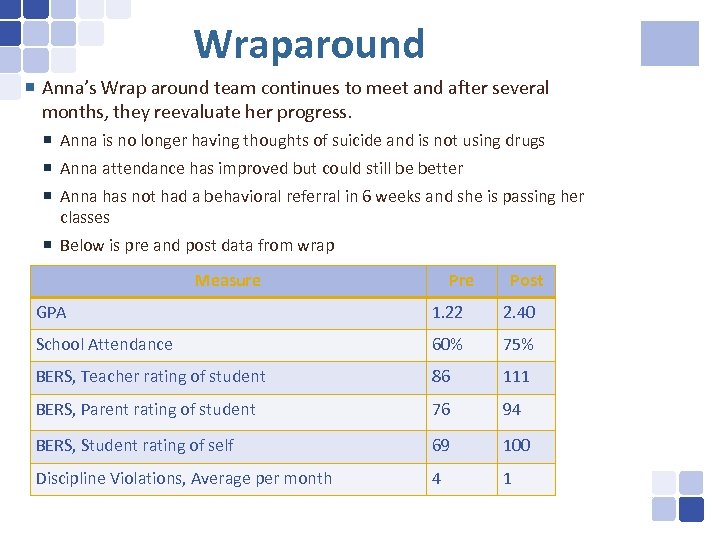
Wraparound ¡ Anna’s Wrap around team continues to meet and after several months, they reevaluate her progress. ¡ Anna is no longer having thoughts of suicide and is not using drugs ¡ Anna attendance has improved but could still be better ¡ Anna has not had a behavioral referral in 6 weeks and she is passing her classes ¡ Below is pre and post data from wrap Measure Post GPA 1. 22 2. 40 School Attendance 60% 75% BERS, Teacher rating of student 86 111 BERS, Parent rating of student 76 94 BERS, Student rating of self 69 100 Discipline Violations, Average per month 4 1
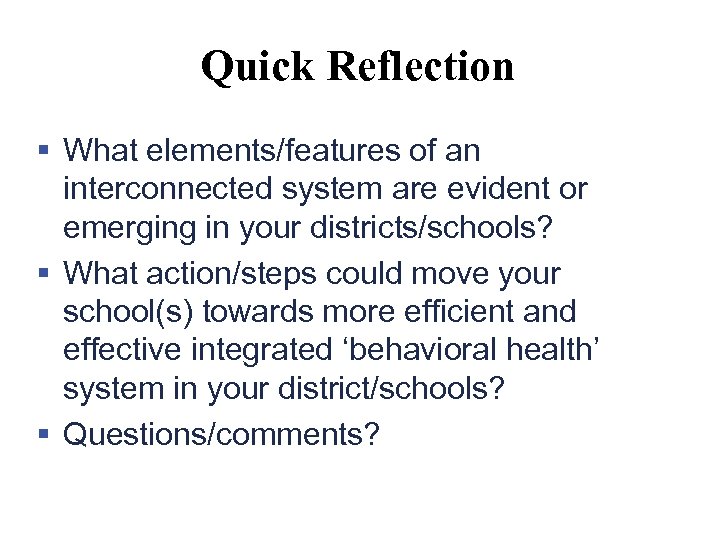
Quick Reflection § What elements/features of an interconnected system are evident or emerging in your districts/schools? § What action/steps could move your school(s) towards more efficient and effective integrated ‘behavioral health’ system in your district/schools? § Questions/comments?
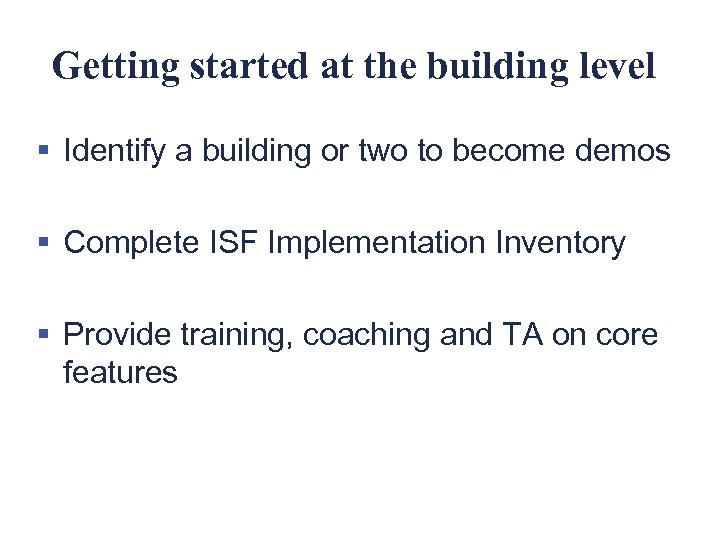
Getting started at the building level § Identify a building or two to become demos § Complete ISF Implementation Inventory § Provide training, coaching and TA on core features

ISF Implementation Inventory

Purpose of ISF Implementation Inventory § To assist school and community partners in their installation and implementation of ISF § To assess baseline and/or ongoing implementation progress of critical ISF features § To inform action planning that advances and enhances ISF implementation § To measure ISF implementation fidelity
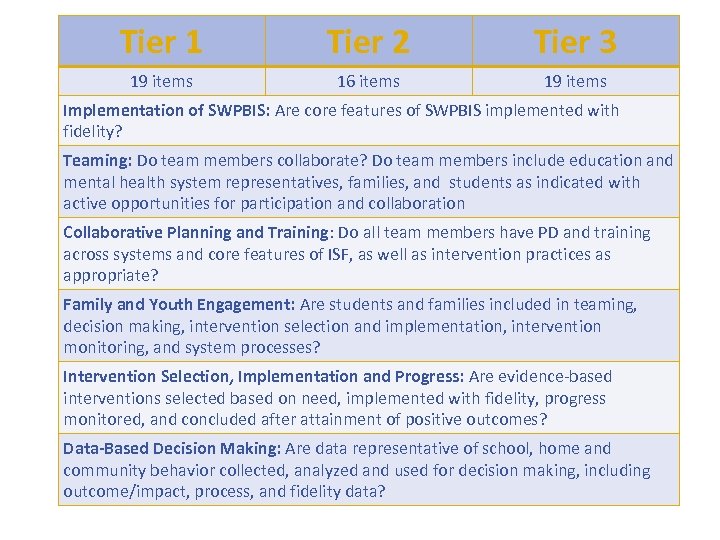
Tier 1 Tier 2 Tier 3 ISF Implementation Inventory: 19 items 16 items 19 items Tiered Domains Implementation of SWPBIS: Are core features of SWPBIS implemented with fidelity? Teaming: Do team members collaborate? Do team members include education and mental health system representatives, families, and students as indicated with active opportunities for participation and collaboration Collaborative Planning and Training: Do all team members have PD and training across systems and core features of ISF, as well as intervention practices as appropriate? Family and Youth Engagement: Are students and families included in teaming, decision making, intervention selection and implementation, intervention monitoring, and system processes? Intervention Selection, Implementation and Progress: Are evidence-based interventions selected based on need, implemented with fidelity, progress monitored, and concluded after attainment of positive outcomes? Data-Based Decision Making: Are data representative of school, home and community behavior collected, analyzed and used for decision making, including outcome/impact, process, and fidelity data?
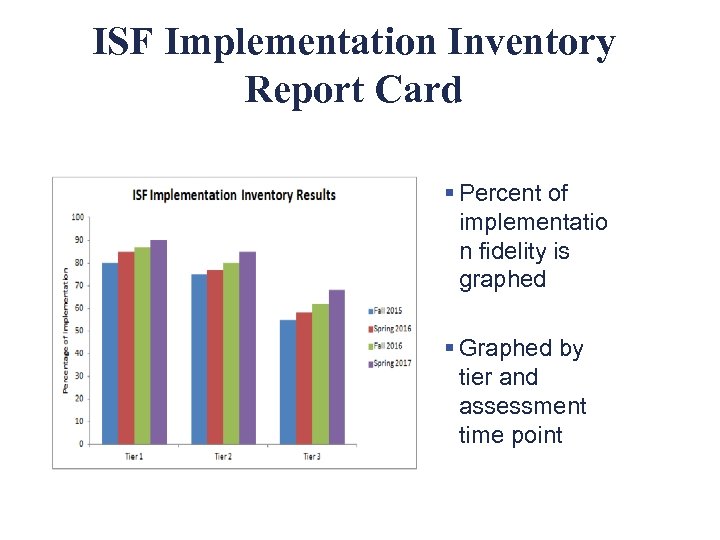
ISF Implementation Inventory Report Card § Percent of implementatio n fidelity is graphed § Graphed by tier and assessment time point
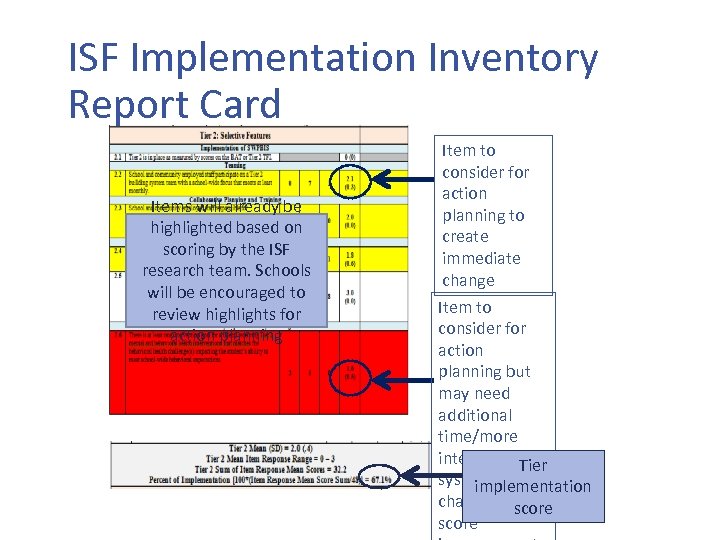
ISF Implementation Inventory Report Card Items will already be highlighted based on scoring by the ISF research team. Schools will be encouraged to review highlights for action planning Item to consider for action planning to create immediate change Item to consider for action planning but may need additional time/more intensive Tier system implementation changes for score
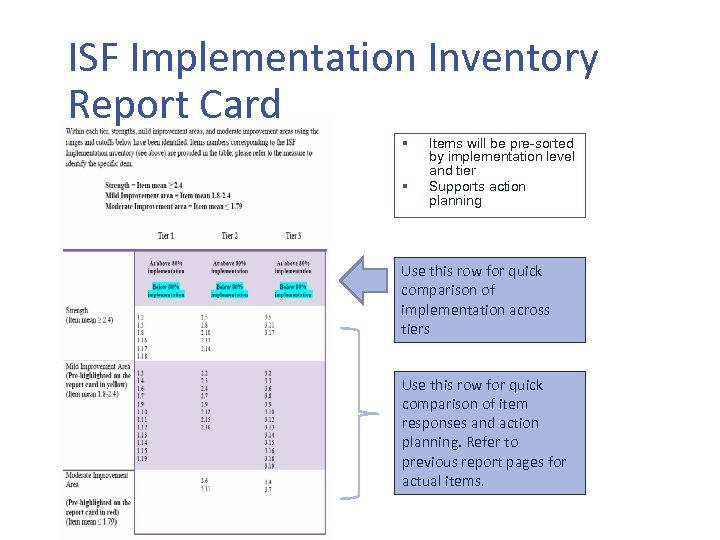
ISF Implementation Inventory Report Card § § Items will be pre-sorted by implementation level and tier Supports action planning Use this row for quick comparison of implementation across tiers Use this row for quick comparison of item responses and action planning. Refer to previous report pages for actual items.
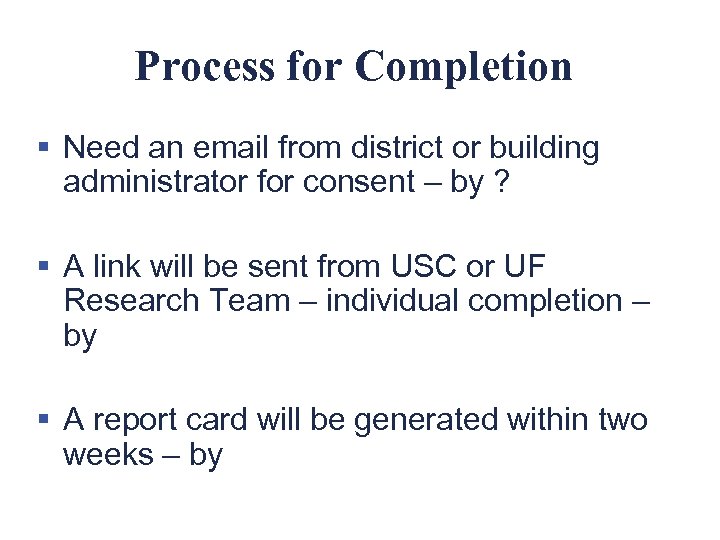
Process for Completion § Need an email from district or building administrator for consent – by ? § A link will be sent from USC or UF Research Team – individual completion – by § A report card will be generated within two weeks – by
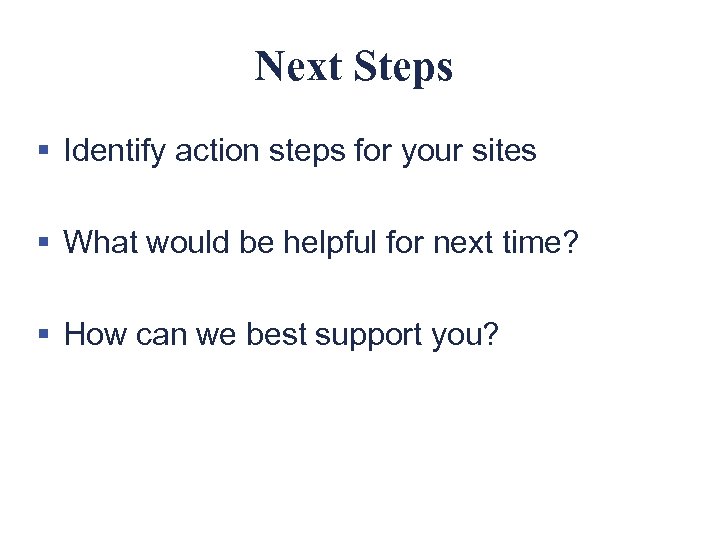
Next Steps § Identify action steps for your sites § What would be helpful for next time? § How can we best support you?
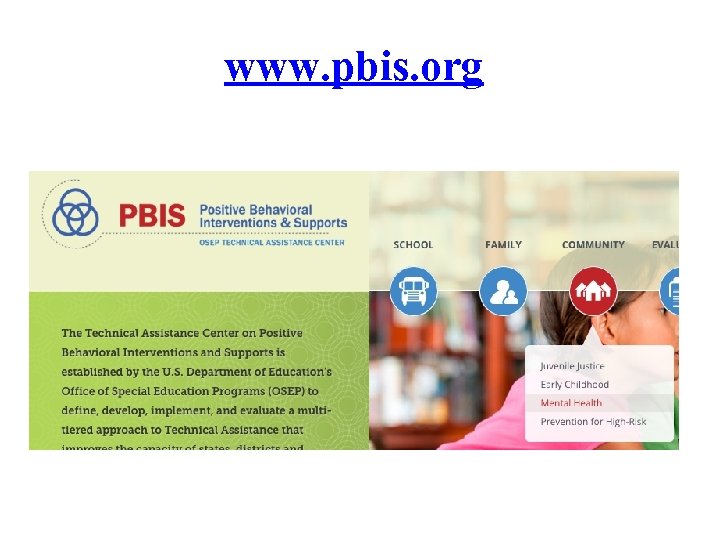
www. pbis. org

www. pbis. org/mentalhealth



Thank You! Kelly Perales Kelly. perales@midwestpbis. org 717 -770 -9365
21ea321b0e2275d5e7b33e83ae1db8d6.ppt